Ancistroteuthis
Ancistroteuthis lichtensteinii
Michael Vecchione, Richard E. Young, and Kotaro TsuchiyaIntroduction
Ancistroteuthis is monotypic. Kubodera et al. (1998), however, briefly described a new form of the species from the Central Atlantic. A. lichtensteinii is best known from the Mediterranean Sea. There, males mature at about 200 mm ML and the species reaches a maximum size of 300 mm ML (Kubodera et al. 1998). This species is very similar to species of Onychoteuthis but is most easily distinguished by the absence of a visible gladius along the mid-dorsal line and the absence of photophores.
Brief diagnosis:
An onychoteuthid ...
- without gladius visible beneath skin in dorsal midline.
- with 8-10 occipital folds.
- without suckers on distal portion of club before terminal pad.
- without photophores.
Characteristics
- Tentacles
- Distal suckers on club restricted to terminal pad.
- Head
- Beaks: Descriptions can be found here: Lower beak; upper beak.
- Occipital folds number 10 (Naef, 1921-23) or 8 - 9 (Kubodera, et al., 1998) on either side of head.
 Click on an image to view larger version & data in a new window
Click on an image to view larger version & data in a new window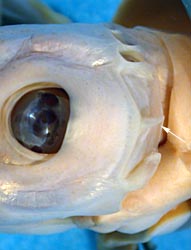
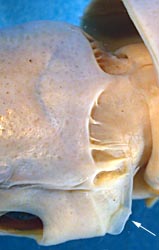
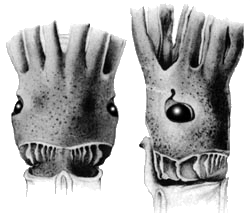
Figure. Left photographs - Lateral and dorsoblique views of the occipital folds, A. lichtensteinii, Type A, preserved, 110 mm ML, 20°27'N, 21°58'W, USNM 294756. Photograph by R. Young.. The white arrows point to occipital fold number 3. Right drawings - Dorsal and lateral views of head and occipital folds, A. lichtensteinii, 145 mm ML, Mediterranean Sea. Drawings from Pfeffer, 1912.
- Beaks: Descriptions can be found here: Lower beak; upper beak.
- Photophores
- Photophores absent.
- Photophores absent.
- Gladius
- Gladius not visible on dorsal side of mantle (i.e., mantle muscle completely surrounds gladius - see title illustrations).
Comments
Additional features of the description can be found here.Kubodera et al. (1998) stated that an oval, opaque area with a small posterior patch of photogenic tissue is present on the ventral covering of the eye. We believe this tissue likely to be iridescent (but not photogenic); observation of live specimens will be necessary to draw any further conclusions.
Kubodera et al. (1998) also briefly described four geographical morphotypes, three forms in the Atlantic and one in the Pacific. The South Atlantic and South Pacific forms, however, belong to Notonykia africanae (Nesis et al. 1998) and Notonykia nesisi (Bolstad 2007) respectively. The other two of their forms are mentioned here as Type A (typical A. lichtensteinii) and Type B; the most distinctive feature of the latter is the rhomboidal, non-attenuate shape of the fins. Insufficient information is available at present to evaluate the significance of these differences.
Life History
Paralarvae have not been described. The smallest described specimen is 16 mm ML. Even at this small size, the mantle covers the gladius at least in its anterior half. The eyes, unlike those of Onychoteuthis at this size, do not have luminous organs on the ventral surface of the eyeball. The conus has a spoon-shape rather than the cone-shape seen in Onychoteuthis. The row of large brownish-red chromatophores on the dorsal midline is probably characteristic. The specimen showed traces of an iridescent metallic sheen, greenish on the mantle and dark blue on the head. This description is from Naef (1921-23).

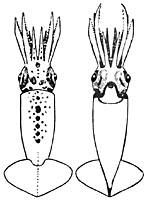
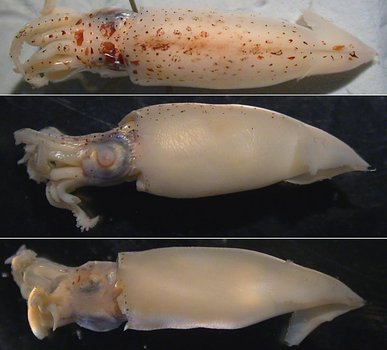
Figure. Dorsal and ventral views of juvenile A. lichtensteinii. Left - 16 mm ML. Drawings from Naef (1921-23). Right - Dorsal, side and ventral views. Photographs by R. Young. The significance of the differences in chromatophore patterns is unknown.
Distribution
The type locality is the Western Mediterranean. This species has been reported from the western Mediterranean, and tropical and subtropical waters of the eastern Atlantic and off Nova Scotia in the western North Atlantic (Vecchione and Pohle, 2002). The records outside the Mediterranean are very sparse. This species has also been reported from the Gulf of Mexico (Voss, 1956) and the southwestern Pacific (Rancurel, 1970), but these identifications are questionable because in both cases the specimens lacked numerous occipital folds. These squids may be young Onykia (Kubodera, et al., 1998, their Moroteuthis).
References
Bolstad, K.S. 2007. Systematics and distribution of the New Zealand onychoteuthid fauna (Cephalopoda: Oegopsida), including a new species, Notonykia nesisi sp. nov. Reviews in Fish Biology and Fisheries, 17: 305–335.
Kubodera, T., U. Piatkowski, T. Okutani and M.R. Clarke. 1998. Taxonomy and Zoogeography of the Family Onychoteuthidae (Cephalopoda: Oegopsida). Smithsonian Contributions to Zoology, No. 586: 277-291.
Naef, A. 1921-23. Cephalopoda. Fauna und Flora des Golfes von Neapel. Monograph, no. 35. English translation: A. Mercado (1972). Israel Program for Scientific Translations Ltd., Jerusalem, Israel. 863pp., IPST Cat. No. 5110/1,2.
Nesis, K. N., M. A. C. Roeleveld and I. V. Nikitina. 1998. A new genus and species of onychoteuthid squid from the Southern Ocean. Ruthenica 8:153-168.
Pfeffer, G. 1912. Die Cephalopoden der Plankton-Expedition. Zugleich eine Monographische Übersicht der Oegopsiden Cephalopoden. Ergebniss der Plankton-Expedition der Humboldt-Stiftung, 2:1-815.
Rancurel, P. l970. Les Contenus Stomacaux d'Alepisaurus ferox dans le Sud-Ouest Pacifique (Cephalopodes). Cahiers O.R.S.T.O.M., serie Oceanographie, 8(4):3-87.
Vecchione, M. and G. Pohle. 2002. Midwater cephalopods in the western North Atlantic Ocean off Nova Scotia. Bull. Mar. Sci. 71(2):883-892.
Voss, G.L. 1956. A Review of the Cephalopods of the Gulf of Mexico. Bulletin of Marine Science of the Gulf and Caribbean, 6(2):85-178.
Title Illustrations

| Scientific Name | Ancistroteuthis lichtensteinii |
|---|---|
| Location | Photographs taken aboard the R/V G. O. Sars, Mar-Eco cruise, central North Atlantic. |
| Comments | Bar is 50 mm. |
| Specimen Condition | Dead Specimen |
| Size | 175 mm ML |
| Image Use |
 This media file is licensed under the Creative Commons Attribution-NonCommercial License - Version 3.0. This media file is licensed under the Creative Commons Attribution-NonCommercial License - Version 3.0.
|
| Copyright |
© 2004

|
About This Page

National Museum of Natural History, Washington, D. C. , USA

University of Hawaii, Honolulu, HI, USA

Tokyo University of Fisheries, Tokyo, Japan
Page copyright © 2019 , , and
 Page: Tree of Life
Ancistroteuthis . Ancistroteuthis lichtensteinii .
Authored by
Michael Vecchione, Richard E. Young, and Kotaro Tsuchiya.
The TEXT of this page is licensed under the
Creative Commons Attribution-NonCommercial License - Version 3.0. Note that images and other media
featured on this page are each governed by their own license, and they may or may not be available
for reuse. Click on an image or a media link to access the media data window, which provides the
relevant licensing information. For the general terms and conditions of ToL material reuse and
redistribution, please see the Tree of Life Copyright
Policies.
Page: Tree of Life
Ancistroteuthis . Ancistroteuthis lichtensteinii .
Authored by
Michael Vecchione, Richard E. Young, and Kotaro Tsuchiya.
The TEXT of this page is licensed under the
Creative Commons Attribution-NonCommercial License - Version 3.0. Note that images and other media
featured on this page are each governed by their own license, and they may or may not be available
for reuse. Click on an image or a media link to access the media data window, which provides the
relevant licensing information. For the general terms and conditions of ToL material reuse and
redistribution, please see the Tree of Life Copyright
Policies.
- Content changed 23 December 2010
Citing this page:
Vecchione, Michael, Richard E. Young, and Kotaro Tsuchiya. 2010. Ancistroteuthis . Ancistroteuthis lichtensteinii . Version 23 December 2010 (under construction). http://tolweb.org/Ancistroteuthis_lichtensteinii/19952/2010.12.23 in The Tree of Life Web Project, http://tolweb.org/




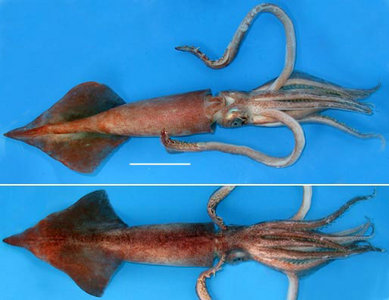
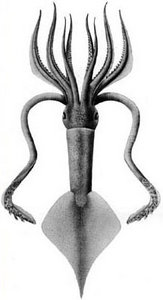
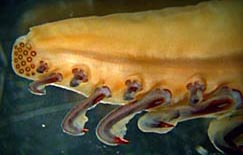




 Go to quick links
Go to quick search
Go to navigation for this section of the ToL site
Go to detailed links for the ToL site
Go to quick links
Go to quick search
Go to navigation for this section of the ToL site
Go to detailed links for the ToL site